
Abstract
The recent development of biological sensors has extended marine plankton studies from conducting laboratory bench work to in vivo and real-time observations. Flow cytometry (FCM) has shed new light on marine microorganisms since the 1980s through its single-cell approach and robust detection of the smallest cells. FCM records valuable optical properties of light scattering and fluorescence from cells passing in a single file in front of a narrow-collimated light source, recording tens of thousands of cells within a few minutes. Depending on the instrument settings, the sampling strategy, and the automation level, it resolves the spatial and temporal distribution of microbial marine prokaryotes and eukaryotes. Cells are usually classified and grouped on cytograms by experts and are still lacking standards, reducing data sharing capacities. Therefore, the need to make FCM data sets FAIR (Findability, Accessibility, Interoperability, and Reusability of digital assets) is becoming critical. In this paper, we present a consensus vocabulary for the 13 most common marine microbial groups observed with FCM using blue and red-light excitation. The authors designed a common layout on two-dimensional log-transformed cytograms reinforced by a decision tree that facilitates the characterization of groups. The proposed vocabulary aims at standardising data analysis and definitions, to promote harmonisation and comparison of data between users and instruments. This represents a much-needed step towards FAIRification of flow cytometric data collected in various marine environments.